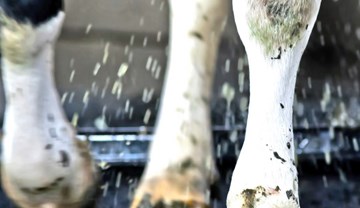- Home
- Husbandry & Prevention
Husbandry & Prevention
Several studies into the incidence of cow mobility problems on UK dairy farms have suggested that the wide range of lameness incidence is primarily due to differences in herd husbandry and management factors.
Dairy cow mobility can be significantly improved through changes to herd management and early detection and prevention of lameness is essential in controlling mobility problems.
Mobility Scoring the herd on a regular basis is the most effective means of identifying those cows that would benefit from early treatment - before the problem becomes serious - along with routine regular foot trimming, particularly at drying-off.
Good welfare is paramount in preventing lameness and results in healthier, more productive and longer-living animals.
Footbathing as a preventative measure - as well as treating certain foot conditions - has become much more valued over recent years as a means of controlling potential contagious hoof problems such as digital dermatitis before they pose a particular problem to the welfare and productivity of the herd. Most cattle mobility experts recognise the value of regular footbathing on the dairy farm; preferably on a daily basis or each time the cows are moved to or from the milking area
Mobility scoring is useful in identifying problem animals, assessing the severity of their mobility problem and monitoring the effectiveness of lameness treatments.
Put simply, it's a way to assess a cow's ability to move easily, without attempting to account for factors influenced by an animal's breeding or conformation in the manner of locomotion scoring.
Mobility assessment should be carried out on a regular basis - ideally at least monthly - by someone, preferably independent of the farm such a mobility mentor - who has the opportunity to see every individual cow in the herd.
Nearly all lameness problems originate around, in or between the claws so routine foot trimming is an important tool for dairy farmers in controlling mobility problems in the herd.
Every dairy cow should have its feet lifted, inspected and if required trimmed at least once every year, ideally at drying-off. If practicable, a further inspection mid-lactation may also be useful in spotting potential problems.
The aims of good foot trimming are:
- Returning hooves to the ideal shape so that they are balanced, better capable of supporting the cow's weight and less likely to be affected by future problems.
- Removing horn around an ulcer or lesion in order to reduce any pain caused by the lesion by reducing the pressure on it as the cow transfers weight onto the claw when walking, promoting increased mobility and aiding healing. This may also involve the fitting of a 'block' or similar device to further reduce the trauma of a lesion.
- Removing dead and diseased horn and other tissue to promote the growth of healthy new horn.
- Removing horn to promote the draining of muck and slurry from around a lesion - and also any pus formed by an infection - to discourage the formation of abscesses
The National Association of Cattle Foot Trimmers provides a database of people who offer trimming services.
Comfortable, well-designed and built cow tracks can reduce lameness and improve dairy cattle mobility.
Good tracks are also important in reducing the incidence of environmental mastitis and keeping udders and teats clean and in good condition.
A well-planned track layout will allow the most efficient use of grazing by providing access to all necessary areas while minimising damage to pastures.
Cleanliness scoring for dairy cows can be used to broadly measure the standard of management of dairy cows such as the incidence of infectious diseases or monitoring cow comfort levels.
It can help to indicate how the incidence of lameness in the herd affects levels of cow cleanliness, and how the levels of cleanliness themselves, such as poor bedding management or insufficient passageway scraping, may be factorial in causing hoof conditions which can lead to mobility problems, such as digital dermatitis and heel horn erosion.
Dirtiness may be related to the health of the cow and her nutrition, but can also be due to the particular habits of the cow when walking, lying down or feeding, or housing management issues.
Linking the results from mobility scoring and cleanliness scoring may indicate important correlations between dirty and lame cows.
Related links and publications

Lameness
Our tools and resources to help you manage lameness on your farm

